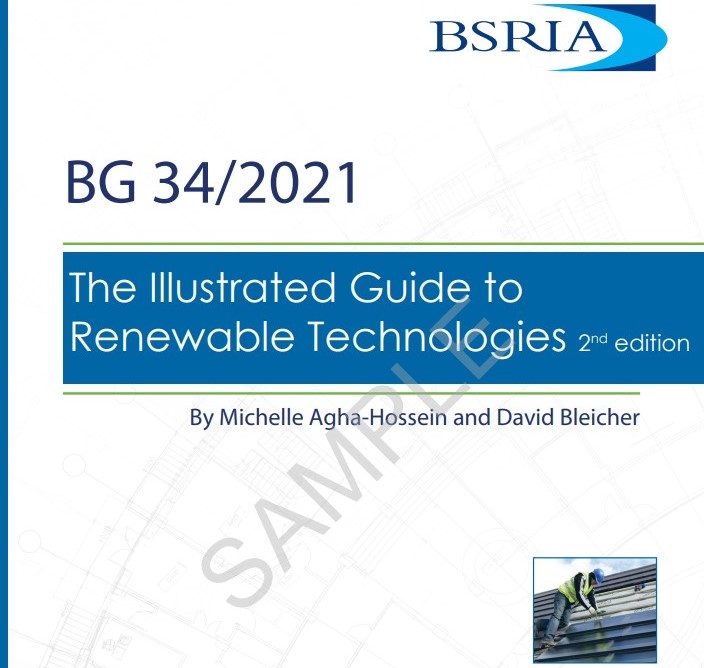Renewable Technologies, a BSRIA illustrated guide

|
In January 2022, BSRIA announced the publication of The Illustrated Guide to Renewable Technologies (BG 34/2021). The guide is intended to benefit construction professionals who do not need to be experts on the topic but need to communicate with those who are.
It introduces the following renewable energy sources, along with an explanation of the different system types for each energy source, where to use them in buildings, and application considerations:
The publication also considers other technologies, such as solar cooling, wind power, and allied technologies such as absorption cooling, fuel cells, energy storage systems and district heating and cooling. The guide also looks at grid-scale renewable energy technologies such as wind farms, solar farms and hydroelectricity.
With the ever increasing focus on the reduction in energy consumption and CO2 production necessary to meet the target of net zero carbon by 2050, it has become attractive for businesses to consider more deeply the use of renewable sources of energy.
Renewable energy technologies are subject to a variety of legislation concerning their design and installation. There are also incentives which encourage them to be adopted, such as the Climate Change Act 2008, the Renewable Heat Incentive, Feed-in Tariffs, the Future Homes Standard and the Microgeneration Certification Scheme. Not to mention that Building Regulations require new buildings, and certain works to existing buildings, to achieve certain levels of energy efficiency.
As the world moves towards an increasingly present sense of environmental responsibility, publications like the BSRIA Illustrated Guide to Renewable Technologies can help built environment engineers remain at the vanguard of this movement. The guide is part of BSRIA’s “Illustrated Guide to…” series which includes:
- BG 31/2017 The Illustrated Guide to Mechanical Building Services.
- BG 32/2014 Illustrated Guide to Electrical Building Services.
- BG 33/2014 Illustrated Guide to Hot and Cold Water Services.
This article originally appeared on the BSRIA website. It was published in January 2022.
--BSRIA
[edit] Related articles on Designing Buildings
Featured articles and news
RTPI leader to become new CIOB Chief Executive Officer
Dr Victoria Hills MRTPI, FICE to take over after Caroline Gumble’s departure.
Social and affordable housing, a long term plan for delivery
The “Delivering a Decade of Renewal for Social and Affordable Housing” strategy sets out future path.
A change to adoptive architecture
Effects of global weather warming on architectural detailing, material choice and human interaction.
The proposed publicly owned and backed subsidiary of Homes England, to facilitate new homes.
How big is the problem and what can we do to mitigate the effects?
Overheating guidance and tools for building designers
A number of cool guides to help with the heat.
The UK's Modern Industrial Strategy: A 10 year plan
Previous consultation criticism, current key elements and general support with some persisting reservations.
Building Safety Regulator reforms
New roles, new staff and a new fast track service pave the way for a single construction regulator.
Architectural Technologist CPDs and Communications
CIAT CPD… and how you can do it!
Cooling centres and cool spaces
Managing extreme heat in cities by directing the public to places for heat stress relief and water sources.
Winter gardens: A brief history and warm variations
Extending the season with glass in different forms and terms.
Restoring Great Yarmouth's Winter Gardens
Transforming one of the least sustainable constructions imaginable.
Construction Skills Mission Board launch sector drive
Newly formed government and industry collaboration set strategy for recruiting an additional 100,000 construction workers a year.
New Architects Code comes into effect in September 2025
ARB Architects Code of Conduct and Practice available with ongoing consultation regarding guidance.
Welsh Skills Body (Medr) launches ambitious plan
The new skills body brings together funding and regulation of tertiary education and research for the devolved nation.
Paul Gandy FCIOB announced as next CIOB President
Former Tilbury Douglas CEO takes helm.
UK Infrastructure: A 10 Year Strategy. In brief with reactions
With the National Infrastructure and Service Transformation Authority (NISTA).























